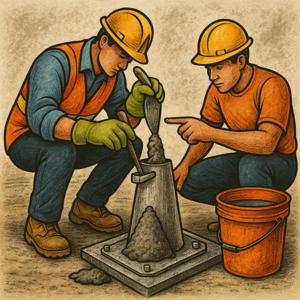SLUMP TEST
 |

A simple and widely used method to measure the consistency (or workability) of fresh concrete before it sets. It helps determine how easily the concrete can be placed and finished.
The test involves filling a slump cone with fresh concrete in layers. Each layer is tamped down with a steel rod to remove air pockets. After the cone is filled, it is lifted vertically, allowing the concrete to slump (settle) downward. The amount the concrete slumps from the original height of the cone is then measured.
The slump test is important when pouring concrete because it checks workability, ensuring the concrete is workable enough for proper placement and compaction without segregation. It helps maintain consistency between batches, ensuring uniformity in concrete quality. It serves as a form of quality control by detecting water content variations or mix issues that could affect strength and durability. Lastly, it helps prevent defects by ensuring the mix isn’t too wet, which would weaken the concrete, or too dry, which would make it hard to place and compact.
Shining a light on over 80 Construction Categories, with unlimited potential for Sub Categories - Watch our Community grow!

